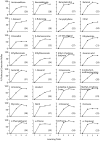Honeybees learn odour mixtures via a selection of key odorants
- PMID: 20161714
- PMCID: PMC2817008
- DOI: 10.1371/journal.pone.0009110
Honeybees learn odour mixtures via a selection of key odorants
Abstract
Background: The honeybee has to detect, process and learn numerous complex odours from her natural environment on a daily basis. Most of these odours are floral scents, which are mixtures of dozens of different odorants. To date, it is still unclear how the bee brain unravels the complex information contained in scent mixtures.
Methodology/principal findings: This study investigates learning of complex odour mixtures in honeybees using a simple olfactory conditioning procedure, the Proboscis-Extension-Reflex (PER) paradigm. Restrained honeybees were trained to three scent mixtures composed of 14 floral odorants each, and then tested with the individual odorants of each mixture. Bees did not respond to all odorants of a mixture equally: They responded well to a selection of key odorants, which were unique for each of the three scent mixtures. Bees showed less or very little response to the other odorants of the mixtures. The bees' response to mixtures composed of only the key odorants was as good as to the original mixtures of 14 odorants. A mixture composed of the other, non-key-odorants elicited a significantly lower response. Neither an odorant's volatility or molecular structure, nor learning efficiencies for individual odorants affected whether an odorant became a key odorant for a particular mixture. Odorant concentration had a positive effect, with odorants at high concentration likely to become key odorants.
Conclusions/significance: Our study suggests that the brain processes complex scent mixtures by predominantly learning information from selected key odorants. Our observations on key odorant learning lend significant support to previous work on olfactory learning and mixture processing in honeybees.
Conflict of interest statement
Figures




References
-
- Laska M, Teubner P. Olfactory discrimination ability for homologous series of aliphatic alcohols and aldehydes. Chem Senses. 1999;24:263–270. - PubMed
-
- Laska M, Galizia CG. Enantioselectivity of odor perception in honeybees (Apis mellifera carnica). Behav Neurosci. 2001;115:632–639. - PubMed
-
- Sachse S, Rappert A, Galizia C. The spatial representation of chemical structures in the antennal lobe of honeybees: steps towards the olfactory code. Eur J Neurosci. 1999;11:3970–3982. - PubMed
-
- Smith B. Analysis of interaction in binary odorant mixtures. Physiol Behav. 1998;65:397–407. - PubMed
-
- Laloi D, Roger B, Blight MM, Wadhams LJ, Pham-Delegue M-H. Individual learning ability and complex odor recognition in the honey bee, Apis mellifera L. J Insect Beh. 1999;12:585–597.
Publication types
MeSH terms
Substances
LinkOut - more resources
Full Text Sources

